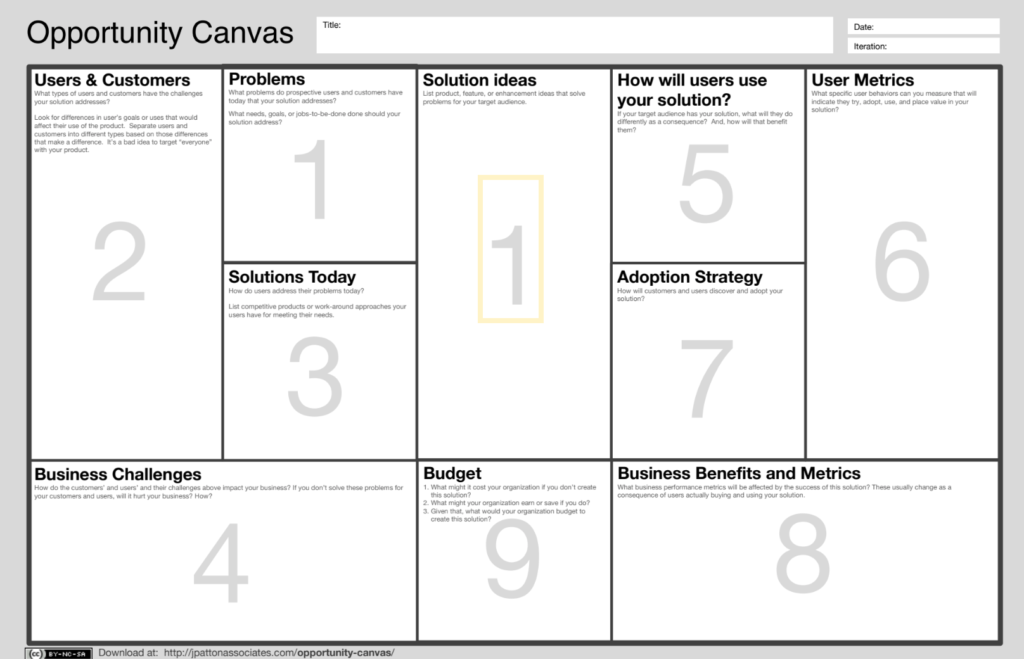Opportunity Assessment Template

Opportunity assessment is critical. By applying it right, product managers will save huge cost for organization. Hence, there must be a schema to validate any product idea before we plan and build it. The opportunity assesssment method is not new, but Marty Cagan is the one who systemized the standard. Since then, the template has been widely adopted by product manager across the world.
Key Takeaways
1. Exactly what problem will this solve? (value proposition)
2. For whom do we solve that problem? (target market)
3. How big is the opportunity? (market size)
4. What alternatives are out there? (competitive landscape)
5. Why are we best suited to pursue this? (our differentiator)
6. Why now? (market window)
7. How will we get this product to market? (go-to-market strategy)
8. How will we measure success/make money from this product? (metrics/revenue strategy)
9. What factors are critical to success? (solution requirements)
10. Given the above, what’s the recommendation? (go or no-go)
Why?
Product managers are haunted by building the right product. So that, the purpose of a good product opportunity assessment is either to:
- Prevent the company from wasting time and money on poor opportunities.
- Or, for those that are good opportunities, to understand what will be required to succeed.
Then, it is not just about you or your product, not just simply either say no or yes to the idea. Also, the communication template would help you communicate upward and to put stakeholders to the same page.
Understanding Opportunity Assessment template
As a part of Product Discovery phase, assessing product idea is applied at very first step. With the proposed template, product managers will need to fill the answers for these ten fundamental questions:
1. Exactly what problem will this solution idea solve? (value proposition)
- Firstly, what problems do prospective users and customers have today that your solution addresses?
- What needs, goals, or jobs-to-be-done should your solution address?
- List product, feature, or enhancement ideas that solve problems for your target audience.
2. For whom do we solve that problem? (target market)
- What types of users and customers have the challenges your solution addresses?
- Then, looking for differences in user’s goals or uses that would affect their use of the product. Bucketing users and customers into different types based on those differences that make a difference. Because, it’s a bad idea to target “everyone” with your product.
3. How big is the opportunity? (market size)
- How do users address their problems today? Then, listing competitive products or work-around approaches your users have for meeting their needs.
4. What alternatives are out there? (competitive landscape)
Next, how do the customers’ and users’ and their challenges above impact your business? and what if you don’t solve these problems for your customers and users, will it hurt your business? And how?
5. Why are we best suited to pursue this? (our differentiator)
If your target audience has your solution, what will they do differently as a consequence? And, how will that benefit them?
6. Why now? (market window)
What specific user behaviors can you measure that will indicate they try, adopt, use, and place value in your solution?
7. How will we get this product to market? (go-to-market strategy)
How will customers and users discover and adopt your solution?
8. How will we measure success/make money from this product? (metrics/revenue strategy)
What business performance metrics will be affected by the success of this solution? Because, these usually change as a consequence of users actually buying and using your solution.
9. What factors are critical to success? (solution requirements)
What might it cost your organization if you don’t create this solution? Then, what might your organization earn or save if you do?
Given that, what would your organization budget tocreate this solution
10. Given the above, what’s the recommendation? (go or no-go)
Lastly, your conclusion, if the problem and solution is big enough, your conclusion may need conducted from a group of stakeholders.
Reading Opportunity Assessment
Additionally, having a closer look, if you look at the template from difference angles, it would provide you different perspectives, and will support your assessment.
Left to Right (needs to outcomes)
From one side, reading from left to right of the template will let you approach and explain the opportunity from NOW (Customers, Problems, Current Solutions and Challenages) to LATER (Proposed solutions, how we do it, our strategy, KPI and required budget).
Top to Bottom (user needs to business needs)
From another side, reading from top to bottom of the template will let you approach and explain the opportunity from user needs to business needs.

For each question, as product manager, you may be not the one who answer it, but your responsibility is to approach the right person to seek for the right answers. They could be your customers, your CxO or Sale team.
Support document
Download PDF Opportunity Assessment template
Reference
Cagan, M. (2017, January 4). Assessing Product Opportunities. Retrieved May 5, 2020, from https://svpg.com/assessing-product-opportunities/